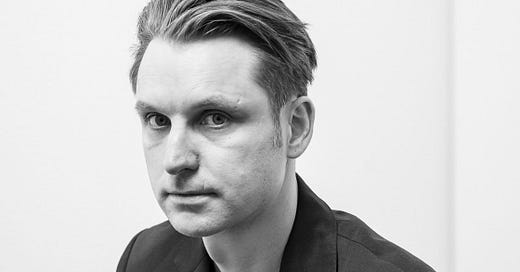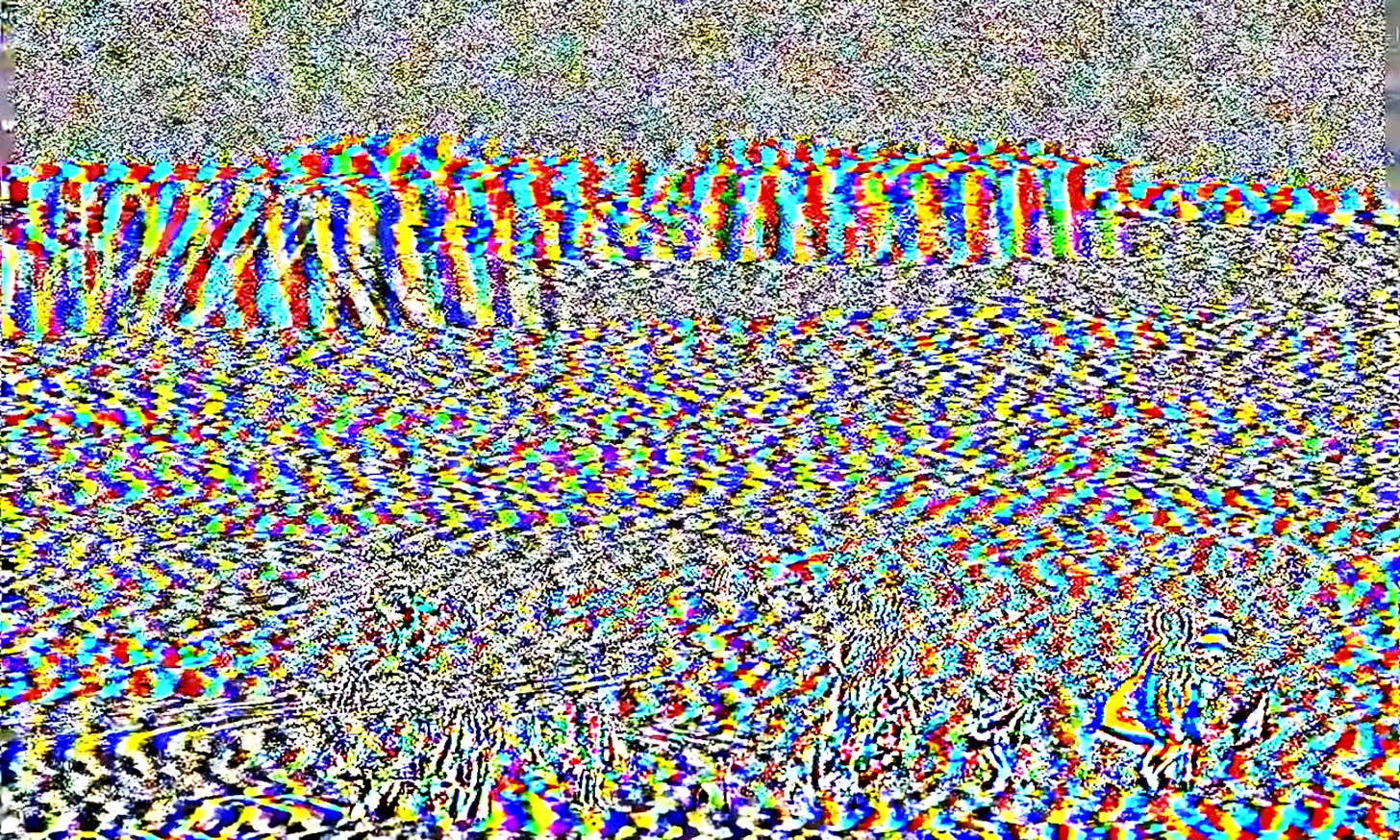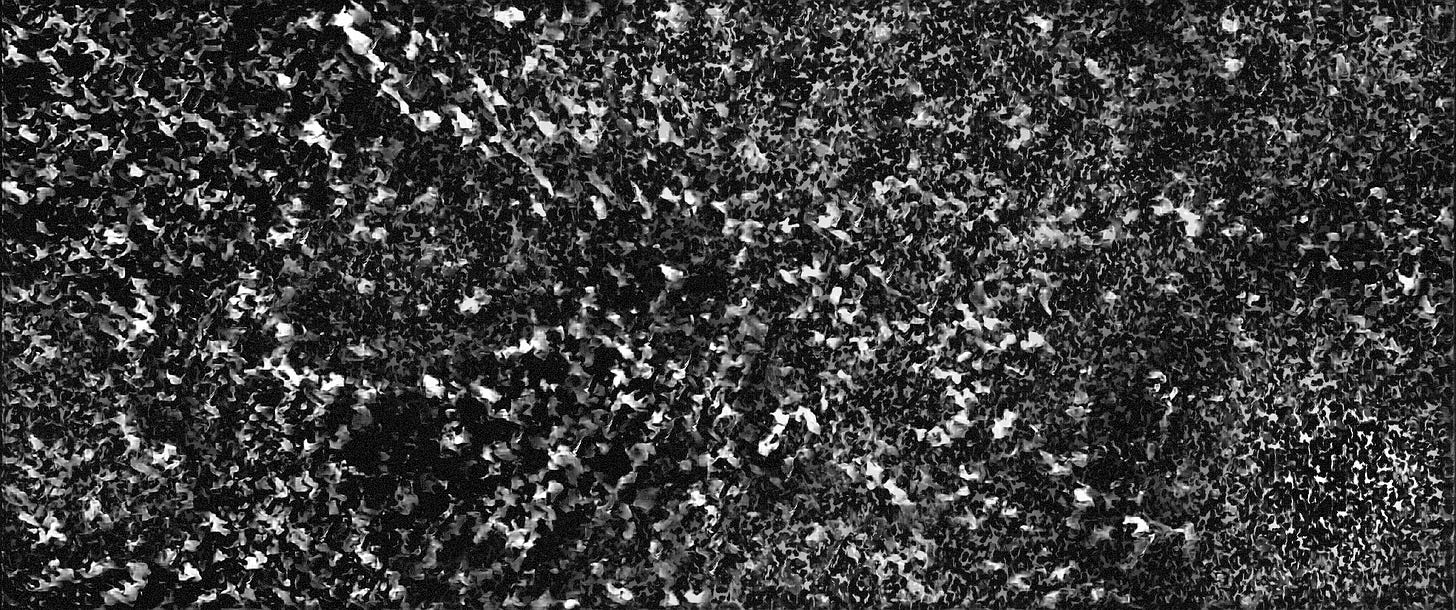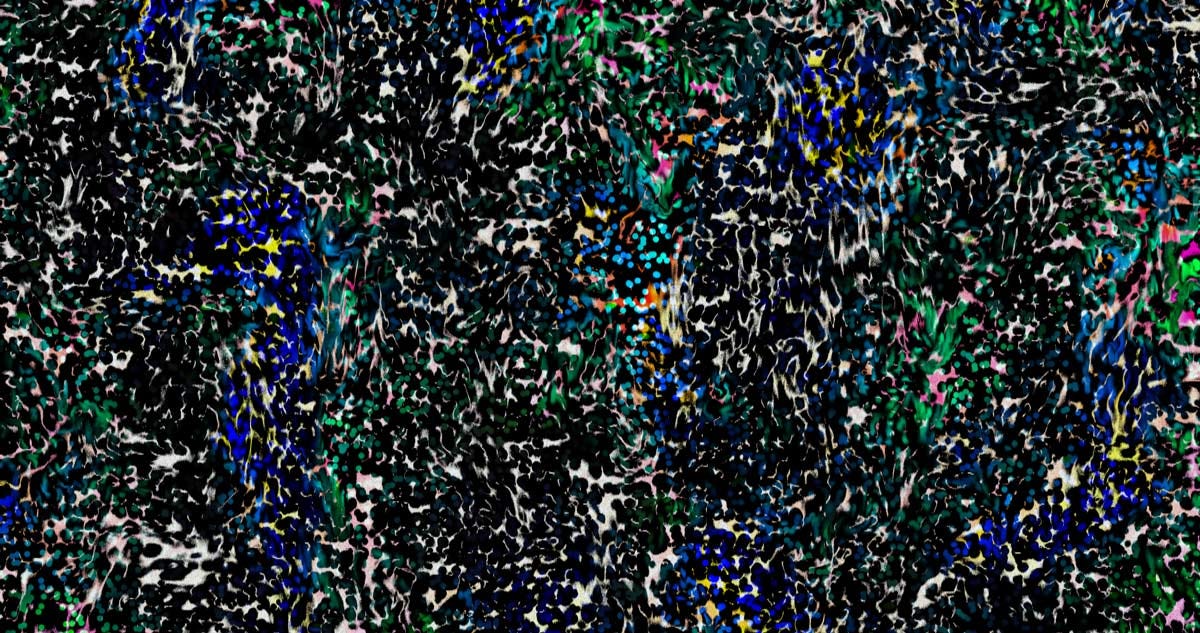016: Rainer Kohlberger
An interview with director Rainer Kohlberger, whose recent films examine Hollywood cinema’s preoccupation with destruction, catastrophe and apocalypse
Welcome to Tune Glue, a newsletter that’s run in conjunction with Tone Glow. While the latter is dedicated to presenting interviews and reviews related to experimental music, Tune Glue is a space for interviews with artists of any kind. These interviews could be with filmmakers, video game designers, perfumers, or musicians who aren’t aligned with what Tone Glow typically covers. Thanks for reading.
Rainer Kohlberger
Rainer Kohlberger is an Austrian-born, Berlin-based filmmaker and audiovisual artist who has used custom software and high-precision technologies to create purely generative films, which strain at the limits of visual representation and human perception. In recent years, Kohlberger has also begun working with machine learning, reinterpreting ‘found footage’ from the history of cinema to explore philosophical questions of consciousness, artificial intelligence, and our own possible extinction.
Mark Cutler talked to Kohlberger on April 6th, 2021 to talk about his films and methods, with a particular focus on three recent films—keep that dream burning (2017), It has to be lived once and dreamed twice (2019), and There must be some kind of way out of here (2020)—which examine Hollywood cinema’s preoccupation with destruction, catastrophe and apocalypse. The second of these films, It has to be lived once and dreamed twice, uses a science-fiction premise to stage an inquiry into the nature of mind and the construction of individual subjectivity. The film anticipated many themes of Reza Negarestani’s influential Intelligence and Spirit (also 2019), in which Negarestani contends that intelligence cannot be reduced to the faculties of an isolated subjectivity, but must be understood as emergent through the interactions of a community of mutually imbricated subjects.
For Kohlberger’s awakening AI, the “I” gives way on both sides to a “we”: it is both always-already embedded in a plurality, without which it is incomplete, and itself contains disjoint and divergent subjectivities which spill beyond the supposed boundary between self and other. Kohlberger’s film in turn draws on a wide variety of thinkers, including Slavoj Žižek, Bruce Sterling, and Naomi Klein, to present a deep and wide-ranging analysis of the human experience.
Mark Cutler: Hi there!
Rainer Kohlberger: Oh hi, how’s it going?
Good. Oh, I can turn my camera on, if you would prefer to—
I thought we could maybe say hello for two minutes and then turn it off.
Okay! Sorry, we just got home, it’s a bit of a disaster here. (gestures) This is all of our stuff, and my partner is dropping off the car. How are things in Berlin?
Good! Except it was snowing today.
Oh, still in April?
Yeah, it was super warm already, almost summery.
We’ve had the same here. I mean, this is supposed to be mid-spring, going into summer, and it’s still so cold. I’m not sure if we’re going to have a summer this year.
How is the situation in New York? Is it weird right now?
I was saying this to a friend of mine the other day… it sounds horrible to say, I’m almost at the point where I’m kind of nostalgic for the early crisis. At least at the time when we went into the first very serious lockdown, it was very clear what everyone had to do. Everything shut all on the same day, and that lasted a little while, but since then, we’re now approaching a year of this semi-reopened state… some things are open, and other things are not open, or they’re only open for reduced hours, and some things you have to wait in a line… and it’s been a year of that! It’s starting to feel like this phase is never going to end, and that part is really wearing me down.
Yeah, I know exactly what you’re talking about. It’s the same here in Berlin.
I thought I’d start by asking: do you remember the first movie that you really loved?
(pauses). Probably, the first one… I mean—let’s turn the picture off, it helps with concentration.
Yeah, it’ll be more like psychoanalysis. You can lay back if you want.
(laughs). Um, I think it was actually Tarkovsky, either Stalker or Solaris. I watched both at the time. Maybe not the movie itself, but being around 17, 18, and finding out about cinema, that there is something else than what is played on TV. I definitely remember that time, and all the auteurs(?) of the French New Wave like Godard, Truffaut… But image-wise, very early on, Kubrick’s Space Odyssey, I still remember the first time on 35mm, it was… I smoked a lot of weed back then (laughter) with my friends, it was a special cinema night. We went and we smoked the whole way.
What interests me about that is, you mentioned that you were probably 16-17. I guess I was kind of expecting you would maybe have one from when you were 6, 7, 8, or maybe 13-14. Would you say you weren’t as interested in cinema back then?
Aaahhh, that’s what you mean. Yeah, it was way later for me. Of course, we went to the movies and everything, but I think there was nothing that really… let me think… I only remember, not one that I loved, but I remember my uncle was looking after us kids, me and my brother. We were quite young, around that age, 6-7, and I remember this movie, Howard The Duck. It was almost like a horror film! I remember I was really scared.
Oooohhhh, I just googled it. I’ve never seen this, but I’ve seen pictures of this grotesque—is it a costume? Is it animatronic? It’s so disturbing. It’s horrible to look at.
It was quite something for a kid. I don’t know, it was a costume I guess.
That experience though is something I relate to. When I was maybe 15, because I’d only really been exposed to pop music on the radio, I was definitely someone who just said I didn’t like music, like “I just don’t care for music.” Which, now, experimental music and avant-garde music are 90% of my life, but it wasn’t until high school when someone just played some noise for me, and I realised that “music” was something that could be so much more.
Mm, yes, music for me was more important from early on. Some pop stuff, Nirvana… there was a really good radio station in Austria. I grew up in the countryside, which is maybe an important part. Before the internet, the radio station really connected you to a world out there. So music was easier to connect to, you could read about it and order it in magazines. So your interest in it gets more and more experimental—well for some people maybe it doesn’t, but for me it definitely did. But for the cinema, there was all the commercial stuff, but there was no experimental cinema, almost none of those non-blockbuster films, no arthouse or whatever you would call it. It was only later, when DVDs came out, and when I went to school in Linz, that I found out about cinema.
It amazes me, especially with short-form cinema, and avant-garde cinema, how difficult and labyrinthine and expensive it can still be to see those films. In so many other ways, there’s so much more infrastructure for streaming music, blockbuster movies, what have you, but it can still be difficult to access the more experimental fringes of cinema.
Mm, it’s a bit hard for me to see, because I’m so into all this festival circuit. I know all the festivals now, but I wouldn’t know where to go in every city. I know what you mean.
The other reason I was kind of interested in your early memories of cinema was because—I don’t want to impose my interpretation, so I’ll put it this way: watching your films again all in sequence, I see a very distinctive break in your approach starting around 2017, with keep that dream burning. Do you see a sort of a change in your method there, and if so, is that tied to anything that you were thinking, or your process around that time?
Yes, I mean you’re definitely right that there’s a break, or not so much a “break,” but a new branch of works. Because I never stopped the other stuff—the last one was More Than Everything. I still do that very much in live performances, which is almost all in this kind of aesthetic, this kind of thinking and approach to what should be seen on the screen, and also heard. But I was definitely interested in not just, (pauses) being a one trick pony (laughter).
Yeah, of course.
But definitely, there was always something in the more perceptual films, which included noise, in a way. It was very much about the flicker and its perceptual effects, but there was always a very noisy quality in it, in some aspects. From there, I went to explore how to visually generate noise, to see what is noise? To read about it, to study it theoretically, to go into it deeply, philosophically. I always did that in a generative way, visually, but also, technically something very important changed. All my work is programmed, I program everything myself. I always create my own toolset, and I bend a lot of different tools to my own needs. Then, machine learning came about, and I integrated that into my toolset.
The ‘break’ then is quite visible, because the films I produced until that point, were all made in software where I could work in real time, which means it’s really like a synthesizer, or like a visual instrument. In a live performance, for example, I do exactly that—I can turn some knobs, and my programming is running in real-time on my laptop. But then, with machine learning, it’s exactly the opposite. It takes hours and hours and days and days to first get any meaningful results that I’m happy with. After I’ve found something, I train some models, and then I transform images with my own models, and that takes ages! This is also interesting to me, because it was always very important that it was in real time, that I could see it, like painting. With the other stuff, I started working more in the tradition of found footage cinema, or ‘searched’ footage cinema, because I was really getting into Hollywood.
With keep that dream burning, and with all my thinking about noise, I found out that if you generate an explosion or fire in software, it’s based on a noise algorithm. It’s the same! This multidirectional noise algorithm by Ken Perlin is everywhere, and once you know it, then you see it everywhere. Noise algorithms have gotten better and better, so it’s not the pure Perlin noise any more, but it’s still there. For me, because it’s made digitally, it was interesting to connect all the explosion scenes from the big action films. A lot of them are the old, cool, real, what do you call it—
Practical effects?
Practical effects! That’s what you call it. Because for fire, it’s still so much better. But for me, it’s still really interesting to connect these analogue, big blockbuster cinema explosion effects—which is the one thing I enjoy about action cinema, you know. Tenet, I really enjoyed it, because it’s the only thing I saw last year, but it’s super dada, it’s about nothing! It’s pure effect. That was actually something I thought about when doing keep that dream burning, taking the pure effect and reducing it to its bare minimum, or taking just that and transforming it into something very digital.
I’m really glad that you mentioned Hollywood cinema, because that’s exactly what I was also thinking about. When I first watched it—I almost don’t want to say this, I’m not sure how you’ll take it, but it almost made me think of the Transformers movies—
Yeah!
This pure, rendered spectacle, this chaos of movement and action—action almost without meaning. Action that just acts. Does that make sense?
Exactly. That was exactly what I tried to say as well, but of course they [Hollywood directors] always have to find some kind of plot, and it’s always this bullshit, I don’t know. But Nolan, he did it with $300 million dollars, and he created a plot that I’m sure he thinks is meaningful. But for nobody else in the world does it make any sense! It’s just three hours of nonsense. But for exactly that aspect, I enjoyed it. Maybe just because it was lockdown, but I got to see it in 70mm.
I haven’t seen Tenet yet, but if I do, I feel like 70mm is the way I’d have to see it too. This reminds me, a few friends of mine, who are very much embedded into the art cinema world, also loved going to see Ready Player One in 70mm. I think for them, there’s a similar experience of sheer visual overload, that you can only achieve with the biggest screen, and the most… the most of everything. It’s a kind of ‘bigness’ that only Hollywood can finance.
And then, with the two that come after that—It has to be lived once and dreamed twice and There must be some kind of way out of here—to me, they deal with three very distinct genres: keep that dream burning, I would say action; It has to be lived once, I think is very concerned with science fiction, and there are images from Metropolis, Frankenstein, Ghost in the Shell, 2001: a Space Odyssey… and then, There must be some kind of way out of here, even though it’s similar in some ways to keep that dream burning, I think there’s a visible difference between these action-y explosions, and then the quiet, horrific, disaster that befalls New York City (both burst into laughter) in watching that film, I could see my own neighbourhood get destroyed by the deluge of… whatever it was, and it was kind of an uncomfortable experience! I’ve seen New York be destroyed in many different ways, but in this film, just watching this sort of wave of particles overtake my building where I live—I don’t know, it was discomfiting. Was that torrent of liquid generated, or was it sourced from somewhere?
Yeah, it’s always New York, right? (laughter). It was 100% sourced. Nothing was generated, just transformed with machine learning. keep that dream burning—what I learned there was the method. You have the flicker sequence there, but with There must be some kind of way out of here, there’s more precision. But you’re right with the descriptions of these films, they are something like a triptych, they somehow belong together. It has to be lived once is definitely also a work on its own, because it has the text which I wrote. I was doing deeper reading, and thinking about all the ways that we think about intelligence, and artificial intelligence. I wanted to explore the philosophy, not on a superficial level, but to understand where the philosophy is based, where this thinking comes from—what is intelligence? You get very quickly into the body-mind problem; it’s one of the basic principles in philosophy.
I combined this with my angle in these films [the ‘triptych’], which was to approach cinema, to ask, “What’s going on in cinema?”, “What’s going on with the sci-fi genre?” and so on. Then I invented this framing, I wanted to create an artificial life form that looks back at humankind, at a time when humans have died out. There’s no more humans on planet Earth, but there’s something that humans have created. Humans have created cinema, and that’s somewhere still on the hard drives or wherever, it’s still there. So, sometime later, an artificial life can access it, and starts to understand, “Who created me?” It was the idea of waking up, and starting to understand what am I, what is the human kind? I started integrating all this thinking about what makes the human human. So, you have this schizophrenic AI, and there are no more humans, but it’s a very humanistic film.
I don’t know, I’m generally a very optimistic person. I don’t have any kind of doomsday thinking in me, but still, I was reflective after the film—the premise was the apocalypse. And with keep that dream burning—the world gets completely destroyed! So I had to ask myself, why did I do that? There was no intention to really think about that. So I started thinking again—and around this time, the ‘doomers’ came up more and more in the media, and then there was the Extinction Rebellion. Apocalyptic thought started getting bigger and bigger in mass media, and talk about the sixth mass extinction—actually Timothy Morton talked about that, which was very inspirational for It has to be lived once and dreamed twice. But my thinking for There must be some kind of way out of here, was to look at what was happening in mass media, to do a bit of reading—Mark Fisher, Žižek, Naomi Klein—and start thinking about what is going on there.
Of course, the apocalypse has been re-performed on the cinema screen for decades, but it’s always ‘something else’. In the ’50s, it was about the Cold War; in the ’60s, and especially the ’70s, it was always about burning skyscrapers, ship and airplane disasters. Later, with special effects, you can start doing it on a bigger scale, destroying whole cities. I wanted to focus on the idea that you have this apocalypse happening on the big screen, Don DeLillo said something like: we need a big catastrophe because everything is so dull, it shocks us for a moment and wakes us up. You go to the cinema, you sit still, you see the world ending, everyone dies, and in the end, everything is back to normal. Nothing really fundamental has to change, it’s just reinstated the capitalist logic that has always been going on. In the world of cinema, it’s always a privatised hero, some individual or individuals that are saving the world. And then everything is there again, it’s very comforting. So in my film, I was going into this genre, all the big disaster scenes, and I wanted to really have the world being—what’s the word—dissolved.
That’s something I think is quite effective. In the history of apocalyptic fiction, there’s something very ideological about it in that there’s either some very well-defined enemy—aliens, swamp monsters, zombies—or it’s a morality tale about war, or fascism… either way, it’s a story about good versus evil, and who’s good and who’s evil is quite well-defined. But to take that away, and just have this colourless goo engulfing the world, without sentience, without malevolence, just the world being… dissolved is the perfect word. It makes it more unnerving, because there’s no villain. It is just happening. Which, if we’re going that way, is probably more likely how it’s gonna happen!
Yeah, that’s the thing. It’s not going to be like the dinosaurs, with a comet coming down—although I read recently, we had a totally wrong understanding of what happened back then. It also took years, a very long time, for them to die out. Like the Big Bang, it was not a puncture, It was not like a boom. It was a very sustained event.
No, it’s true, and we forget how many things—like we think of the dinosaurs as having been eradicated. But of course they weren’t eradicated, some of them became something else. So in a way, the implications from that event are still unfolding now. The event, I think, is still present in a very real way.
Yeah, like Bruce Sterling has this atemporality idea that I really like, that nothing really dies, and everything is still present. They’re all still there.
More information about Rainer Kohlberger’s films can be found on his website.
Thank you for reading the sixteenth issue of Tune Glue. Let’s stick around until our world dissolves.
If you appreciate what we do, please consider donating via Ko-fi or becoming a Patreon patron. Tune Glue is dedicated to forever providing its content for free, but please know that all our writers are paid for the work they do. All donations will be used for paying writers, and if we get enough money, Tune Glue will be able to publish issues more frequently.







